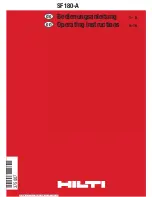
| English
6
ENGLISH
GENERAL POWER TOOL SAFETY WARNINGS
Read all safety warnings and all instructions. Failure
to follow the warnings and instructions may result in
electric shock, fire and/or serious injury. Save all warn
-
ings and instructions for future reference. The term
“power tool” in the warnings refers to your mains-op-
erated (corded) power tool or battery-operated
(cordless) power tool.
WORK AREA
h
Keep work area clean and well lit. Cluttered or dark
areas invite accidents.
h
Do not operate power tools in explosive atmo-
spheres, such as in the presence of flammable liquids,
gases or dust. Power tools create sparks which may
ignite the dust or fumes.
h
Keep children and bystanders away while operating a
power tool. Distractions can cause you to lose control.
ELECTRICAL SAFETY
h
Power tool plugs must match the outlet. Never modify
the plug in any way. Do not use any adapter plugs with
earthed (grounded) power tools. Unmodified plugs
and matching outlets will reduce risk of electric shock.
h
Avoid body contact with earthed or grounded surfac-
es, such as pipes, radiators, ranges and refrigerators.
There is an increased risk of electric shock if your body
is earthed or grounded.
h
Do not expose power tools to rain or wet conditions.
Water entering a power tool will increase the risk of
electric shock.
h
Do not abuse the cord. Never use the cord for carrying,
pulling or unplugging the power tool. Keep cord away
from heat, oil, sharp edges and moving parts. Damaged
or entangled cords increase the risk of electric shock.
h
When operating a power tool outdoors, use an exten-
sion cord suitable for outdoor use. Use of a cord suit
-
able for outdoor use reduces the risk of electric shock.
h
If operating a power tool in a damp location is unavoid-
able, use a residual current device (RCD) protected
supply. Use of an RCD reduces the risk of electric shock.
PERSONAL SAFETY
h
Stay alert, watch what you are doing and use common
sense when operating a power tool. Do not use a
power tool while you are tired or under the influence
of drugs, alcohol or medication. A moment of inatten-
tion while operating power tools may result in serious
personal injury.
h
Use personal protective equipment. Always wear eye
protection. Protective equipment such as dust mask,
non-skid safety shoes, hard hat, or hearing protection
used for appropriate conditions will reduce personal
injuries.
h
Prevent unintentional starting. Ensure the switch is in
the off-position before connecting to power source
and/or battery pack, picking up or carrying the tool.
Carrying power tools with your finger on the switch
or energizing power tools that have the switch on in-
vites accidents.
h
Remove any adjusting key or wrench before turning
the power tool on. A wrench or a key left attached to a
rotating part of the power tool may result in personal
injury.
h
Do not overreach. Keep proper footing and balance
at all times. This enables better control of the power
tool in unexpected situations.
h
Dress properly. Do not wear loose clothing or jewel-
ery. Keep your hair, clothing and gloves away from
moving parts. Loose clothes, jewelery or long hair can
be caught in moving parts.
h
If devices are provided for the connection of dust
extraction and collection facilities, ensure these are
connected and properly used. Use of dust collection
can reduce dust-related hazards.
POWER TOOL USE AND CARE
h
Do not force the power tool. Use the correct power
tool for your application. The correct power tool will
do the job better and safer at the rate for which it was
designed.
h
Do not use the power tool if the switch does not turn
it on and off. Any power tool that cannot be controlled
with the switch is dangerous and must be repaired.
h
Disconnect the plug from the power source and/or
the battery pack from the power tool before making
any adjustments, changing accessories, or storing
power tools. Such preventive safety measures reduce
the risk of starting the power tool accidentally.
h
Store idle power tools out of the reach of children and
do not allow persons unfamiliar with the power tool or
these instructions to operate the power tool. Power
tools are dangerous in the hands of untrained users.
h
Maintain power tools. Check for misalignment or
binding of moving parts, breakage of parts and any
other condition that may affect the power tool’s op
-
eration. If damaged, have the power tool repaired be-
fore use. Many accidents are caused by poorly main-
tained power tools.
h
Keep cutting tools sharp and clean. Properly main
-
tained cutting tools with sharp cutting edges are less
likely to bind and are easier to control.
h
Use the power tool, accessories and tool bits etc.
in accordance with these instructions, taking into
account the working conditions and the work to be
performed. Use of the power tool for operations dif
-
ferent from those intended could result in a hazard-
ous situation.
SERVICE
Have your power tool serviced by a qualified repair
person using only identical replacement parts. This
will ensure that the safety of the power tool is main-
tained.
SPECIFIC SAFETY REQUIREMENTS FOR DRILLS
h
Wear ear protectors when impact drilling.
h
Hold the power tool by insulated gripping surfaces
when performing an operation where the cutting
accessory may contact hidden wiring or its own cord.
Cutting accessory contacting a ”live” wire may make
exposed metal parts of the powertool ”live” and
could give the operator an electric shock.
h
Switch off the power tool immediately when the tool
insert jams. Be prepared for high reaction torque that
ID 710 PRO







































